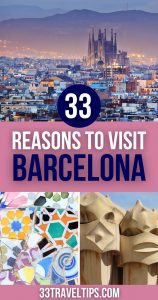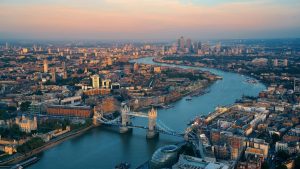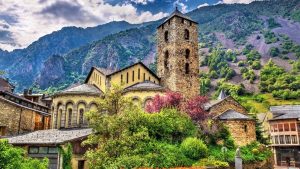
If you’re planning your next Spanish adventure, let us tell you this:
Barcelona is worth visiting for its inspiring architecture, rich culture, tasty food, exciting nightlife, and excellent football. Design lovers will love the dazzling Casa Batlló; nature buffs – the striking Tibidabo; food aficionados – Catalan cuisine; and culture vultures – the diverse museums.
In this article, you’ll find the top 33 reasons to visit Barcelona, Spain. Even before you reach the end of this post, you’ll understand why people love to travel to the Catalan capital.
Are you ready to explore the second-largest Spanish city?
Then, let’s jump right in!
✅ Note: This article contains affiliate links. In case you purchase something through one of these links, we may receive a small commission at no extra cost to you. Thank you for helping us keep creating the free content on this website!
Go to Barcelona for the Mind-bending Architecture
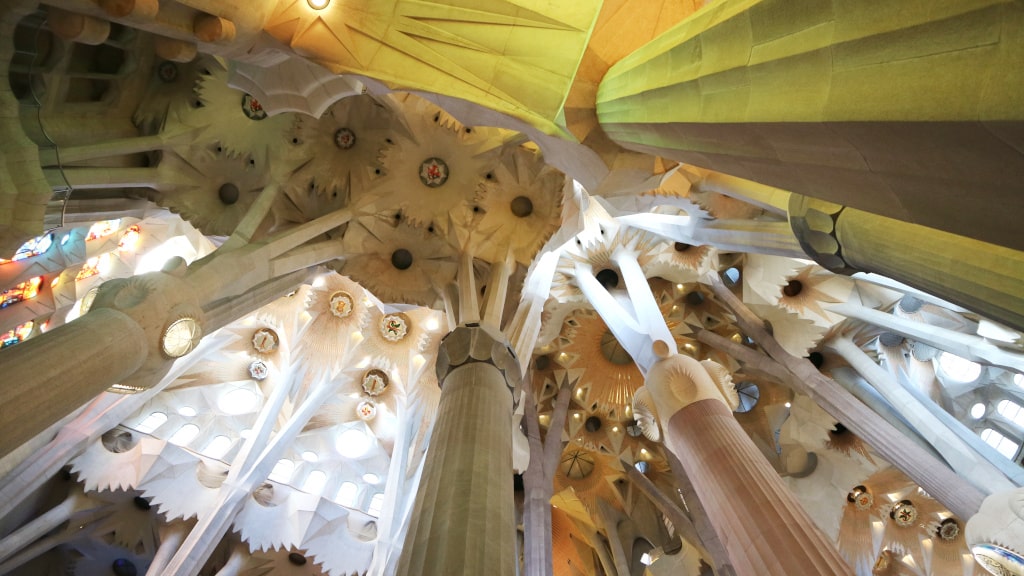
Barcelona is famous for its eccentric churches, magnificent townhouses, and eclectic architectural fusions. The city’s diverse neighborhoods combine Gothic, Baroque, Romanesque, and Modernist structures. Nine buildings, the works of two genius architects – Antoni Gaudí and Lluis Domenech i Montaner – are on the UNESCO World Heritage List. Below, you’ll find the most incredible buildings which make Barcelona worth visiting.
- La Sagrada Familia. Antoni Gaudi’s unfinished masterpiece is the most recognizable structure in the Catalan capital. One of the craziest facts about Barcelona is that the jaw-dropping basilica will take 7x longer to complete than the Great Pyramids of Giza. The construction of one of the world’s most famous churches began in 1882. After Gaudi’s death, several renowned architects continued his greatest work. Sagrada Familia’s projected completion is 2026, almost 140 years after construction began.
- Casa Batlló. In 1900, Josep Batlló bought an unremarkable house on Passeig de Gràcia due to its central location. He commissioned Gaudí to redesign his new home. The result? A dazzling blend of colors and shapes. As a typical Modernism example, Casa Batlló incorporates stone, forged iron, ceramics, and colorful mosaics. The shape of the house follows the legend of San Jordi. If you look closely at the façade, you’ll notice the dragon-shaped roof, the sword-shaped chimney, and the tiles representing the river, colored by the dragon’s blood. If you want a unique experience for your senses, join the interactive Casa Batlló 10-D Tour.
- Casa Milà. Arguably the most unusual yet distinctive house of the architect, Casa Milá is among the top Gaudi buildings in Barcelona. Due to its innovations and decorative solutions, the building is Gaudi’s most emblematic work of civic architecture. Erected between 1906 and 1912, Casa Milá was the architect’s last private residence. The façade features forms drawn from nature. The cherry on top is the mind-boggling rooftop terrace where Gaudi unleashed his creative genius. The intricately decorated vents, chimneys, and fixtures mimic a city skyline.
- Hospital de Sant Pau. Another Catalan genius, the architect Lluís Domènech i Montaner, created this fantastic Art Nouveau mixture of arches, statues, and stained glass. He redesigned the building after its former owner Paul Gil i Serra died. Serra’s last wish stated that his estate had to serve as a hospital. The edifice no longer fulfills this function, but you can explore the mind-boggling architectural masterpiece. Since 1997, Recinte Modernista de Sant Pau has been a UNESCO World Heritage Site, and visiting it is one of the most unusual things to do in Barcelona.
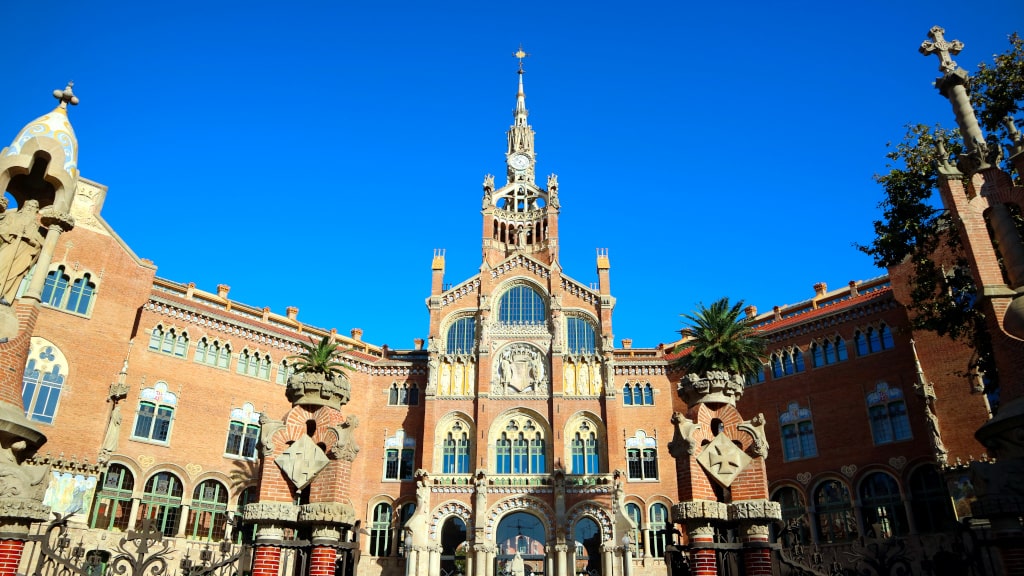
- Palau de la Música Catalana. Domènech i Montaner also created Palau de la Música Catalana, a magnificent concert hall with striking decor. The façade will blow your mind with its shapes and sculptures, while the interior will stun you with its elaborate woodwork and stained glass. The hall is home to Orfeó Català, a choir and orchestra, that has been active since 1891. You can attend a concert or visit the UNESCO World Heritage Site on an audio-guided tour.
- Barcelona Cathedral. The Gothic Cathedral of the Holy Cross and Saint Eulalia was erected between the 13th and 15th centuries. It’s dedicated to the co-patron saint of Barcelona. The young virgin Eulalia suffered martyrdom during the Roman reign of the region. In the cathedral’s crypt, you can visit her tomb. The Barcelona Cathedral also features a secluded cloister. If you’re looking for a peculiar site to visit, check out its yard. It’s home to 13 beautiful white geese, which symbolize Eulalia’s age when she was killed.
- Columbus Monument. Standing at the lower end of La Rambla, you’ll find a 197-ft. (60-m) tall monument. It consists of an ornate pedestal topped by a bronze statue of Christopher Columbus. The landmark was erected for the 1888 Barcelona World Fair and should have been pointing towards the New World. In reality, however, Columbus is stretching his finger towards Algeria and the African continent.
- Arc de Triomf. The name of this glorious structure suggests it was built to commemorate a victory. Peculiarly, that’s not the case. Barcelona’s triumphal arch was built for the 1888 Barcelona World Fair to serve as the main entrance to the exposition. The architect Josep Vilaseca i Casanovas designed the redbrick structure in the Neo-Mudéjar style. Sculptures and stone carvings, dedicated to the host and the participants in the World Exposition, adorn Arc de Triomf’s sides.
- The Magic Fountain of Montjuïc. Similar to the famous dancing fountains in Dubai and Las Vegas, Barcelona hosts its own water and light shows. The Magic Fountains’ hydraulics and lightning equipment can produce a whopping 7 billion light and water combinations. Barcelona’s water cascades were built in 1929 in the Art Deco style. Their spectacles feature compositions varying from Spanish classical music to cartoon soundtracks and 1980s pop hits. Consult Barcelona’s official website for the current timetable and choreographies.
Travel to Barcelona for the Incredible Attractions
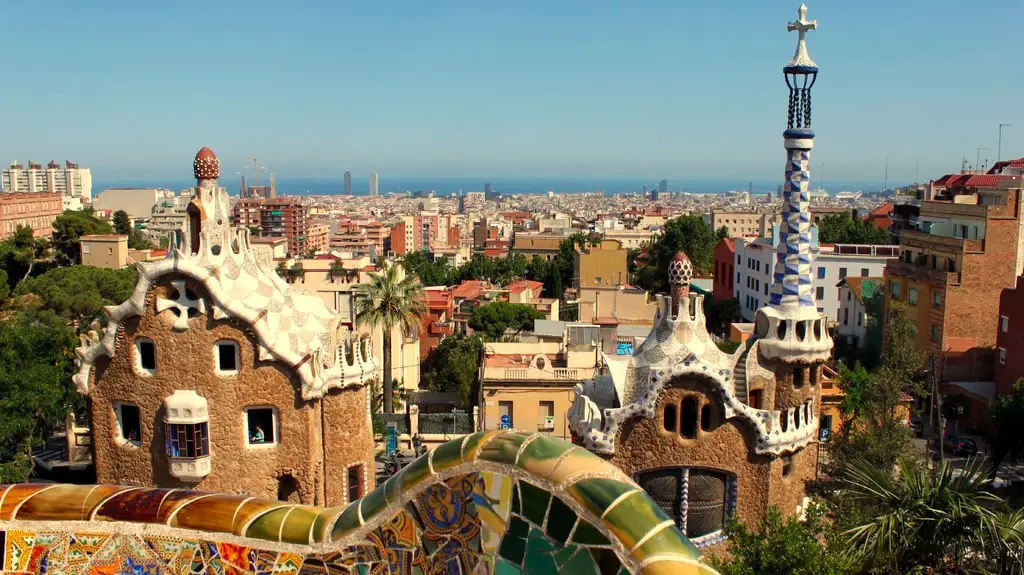
Barcelona is worth visiting for its countless attractions. Among them are chill recreational areas, fascinating open-air museums, and majestic plazas. Find the most exceptional ones below.
- Park Güell. In the magnificent Park Güell, lush gardens and peculiar architectural elements coexist. Inside, you can marvel at some of the most recognizable works of Antoni Gaudí. In the UNESCO-listed site, Gaudí unleashed his artistic fantasies. The sculptures he produced dazzle visitors with their nature-inspired splendor. The park also reveals a spectacular panorama of Barcelona. To learn everything about the genius’ masterpiece, we recommend joining this guided tour.
- Montjuïc. The steep Montjuïc hill is one of the most distinctive places in Barcelona. On its top, you can visit the 17th-century Montjuïc Castle. The open-air Poble Espanyol, the National Art Museum of Catalonia, the monumental Montjuïc Cemetery, the Joan Miró Foundation, and many of the 1992 summer Olympics facilities occupy its slopes. Recreational spaces featuring rose gardens, cacti landscapes, and hedge mazes invite for a leisurely walk. The coolest way to reach Montjuïc is by cable car. Buses and staircases also lead to the top of the hill.
- Tibidabo. Rising on the northwest of Barcelona, Tibidabo offers fantastic views of the city and the Mediterranean. At the summit, you’ll find the Sagrat Cor Church, Tibidabo Amusement Park, and Torre de Collserola. A monumental neo-Gothic statue of Jesus Christ tops the Sagrat Cor Church. The temple resembles a Romanesque fortress and boasts an intricate décor. The historic Tibidabo Amusement Park dates back to 1899. It’s one of the oldest still-functioning theme parks in the world. The 946-ft. (288-m) tall Collserola Tower serves as a communication and observation platform.
- Parc de la Ciutadella. Barcelonans’ favorite green space is the 19th-century Parc de la Ciutadella. It houses Gaudi’s first collaboration, the jaw-dropping Cascada del Parc de la Ciutadella. The architect didn’t participate in the design of the stunning fountain but constructed its purification system. In Parc de la Ciutadella, you’ll also find the Parliament of Catalonia and Barcelona Zoo, as well as ponds, monuments, and green spaces.

- Poble Espanyol. Erected for the 1929 Barcelona International Exposition, the Spanish Village is an open-air architectural museum. It consists of 117 full-scale replicas of typical buildings from different Spanish regions. The houses, palaces, squares, and whole streets in diverse architectural styles. Gothic, Renaissance, Mudéjar, and Modernism are represented, creating a unique atmosphere. In Poble Espanyol, you can also explore a theater, several restaurants, multiple artisan workshops, as well as a museum of contemporary art.
- Barcelona’s beaches. The city’s 2.8-mi (4.5-km) coastline is home to seven blue-flagged beaches. Interestingly, until the 1992 Olympics, Barcelona had no beaches at all. At this time, the seaside was primarily an industrial zone. All of the beaches are artificial and covered with sand imported from Egypt. The oldest and most popular are Barceloneta, Sant Sebastià, and Somorrostro. However, if you want to go where locals prefer to sunbathe, visit Nova Icària, Bogatell, or Mar Bella.
- Plaça de Catalunya. The majestic square is the heart of Barcelona. Plaça de Catalunya occupies a gigantic area and houses intricate fountains and statues. The square often hosts important events. Luxury hotels, shopping centers, and cafés surround it. From here, several important streets start. Find our insider tip for a budget-friendly restaurant with priceless views of Barcelona on the last floor of the department store El Corte Inglés.
- Plaça d’Espanya. One of Barcelona’s largest junctions was built for the 1929 International Exposition. Plaça d’Espanya’s most distinguishable features are the fountain in the center of the plaza and the pair of 154-ft. (47-m) tall Venetian towers. Right next to Plaça d’Espanya, you’ll find the gorgeous Arenas de Barcelona. The former bullring is currently one of the city’s most popular shopping malls. Go to its rooftop terrace at sundown for an incredible 360°-panorama of Barcelona.
Visit Barcelona for the Astonishing Museums
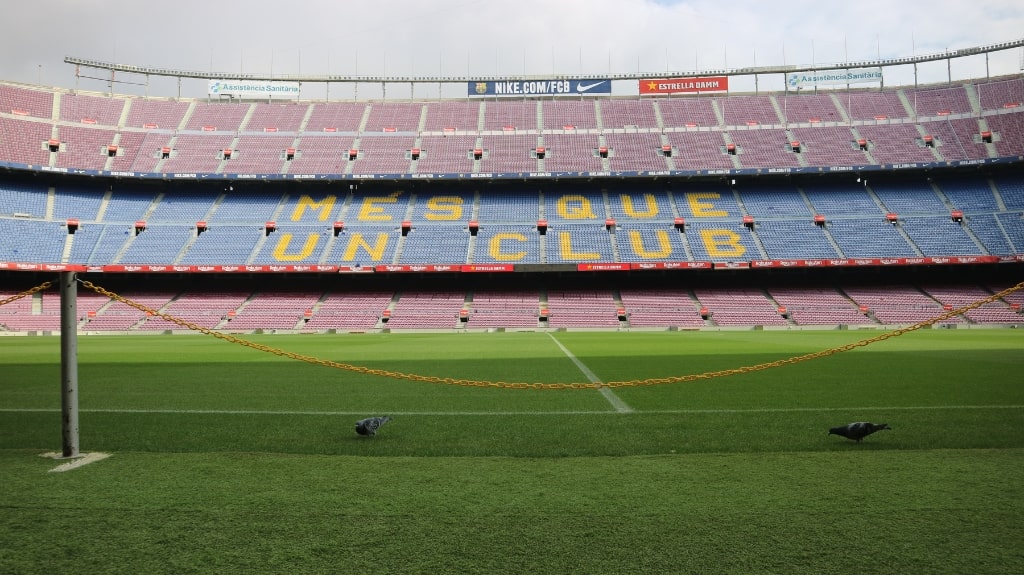
Barcelona is heaven for museum aficionados. One of our top Barcelona travel tips for saving money is to visit the 60+ institutions when they offer free entry. If that doesn’t work for your travel dates, you can get the Barcelona Card with free entry to over 25 museums and free public transport in the city. Let’s find out which of the incredible collections will strike your fancy.
- FC Barcelona Museum. Barcelona is home not only to one of the best football clubs on the planet but also to the largest stadium in Europe. With a capacity of almost 100K spectators, Camp Nou is also the 12th-largest in the world. FC Barcelona Museum, which is inside the stadium, is the city’s most visited museum. This is quite impressive when you have in mind the number of museums in Barcelona. Annually, more than 1.6 million people explore the exhibition halls at Camp Nou. With 75 domestic trophies and 20 European and world titles, one of the best football teams in the world has a lot to show.
- Museu Nacional d’Art de Catalunya. The art gallery sits on the slopes of Montjuïc right above the Magic Fountain and Plaça d’Espanya. It occupies Palau Nacional, an imposing palace built for the 1929 Barcelona International Exposition. In its halls, you can follow 1,000 years of Catalan and Spanish art history through Romanesque, Gothic, Renaissance, Baroque, and Modernist collections. The diversity of paintings, sculptures, frescoes, altarpieces, murals, and photographs will blow your mind.
- Picasso Museum. Five adjoining medieval palaces host Museu Picasso. The exhibition displays more than 4,000 works by Pablo Picasso, including paintings, drawings, sculptures, and ceramics. The collection is the second-largest in the world. The items span the artist’s entire career. Some of the highlights are paintings from his Blue Period, Rose Period, and Cubist Period. The museum also features works by artists who influenced Picasso. Among them are El Greco, Velázquez, and Degas.
- IDEAL Centre d’Arts Digitals de Barcelona. At IDEAL Centre, you can immerse yourself in a cybernetic world of art through futuristic projections and VR technology. IDEAL Centre d’Arts Digitals de Barcelona organizes exhibitions, which bring the fantastic creations of great artists such as Picasso, Klimt, Frida Kahlo, and Dalí to life. Currently, you can explore Salvador Dali’s interpretation of quantum physics, the parallel universe, DNA sequencing, sacred geometry, and the fourth dimension through innovative audiovisual effects.
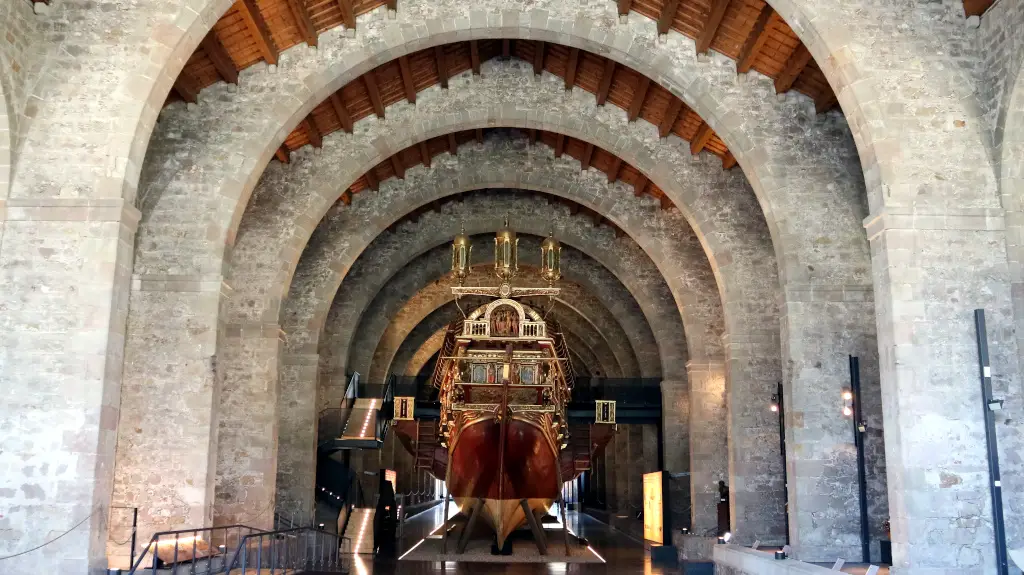
- Maritime Museum of Barcelona. Explore the rich nautical history of Barcelona at the exceptional Maritime Museum. Inside the former shipyards, you can walk over the spectacular replica of the royal galleon from the Battle of Lepanto. The conflict in 1571 between the Holy League and the Ottoman Empire decided the division of the Mediterranean region. Other cool features of the museum include displays of maps, naval tools, and dioramas inside cut shipping containers. Ictineo I, the first-ever engine-powered submarine, launched off the coasts of Barcelona in 1858, also has a prominent spot in the museum’s collection.
- Museu de la Ciència CosmoCaixa. In CosmoCaixa, you can experiment with the laws of physics, observe plants, animals, and objects, and learn using your senses. The interactive science museum features exhibitions on anthropology, geology, physics, biology, and astronomy. It provokes scientific thinking in both adults and children. The most striking display in Museu de la Ciència CosmoCaixa is the flooded Amazon rainforest. On your walk through the jungle, you can meet more than 100 living species. Fish, birds, plants, and mammals share the manmade habitat inside CosmoCaixa.
- Museu del Rei de la Màgia. The first museum of magic in the world was established in Barcelona. Museu del Rei de la Màgia opened in 1881 and still welcomes visitors today. You can browse through the history exhibition and check out the enchanting shop, before entering the theater to witness a magic show. The museum’s collection contains artifacts about famous magicians and the technology behind their tricks and illusions. Some of the displays are interactive. The theater hosts performances by professional magicians and illusionists, while the shop offers magic tricks, books, and souvenirs related to magic.
Visit Barcelona for the Culinary Orgasms
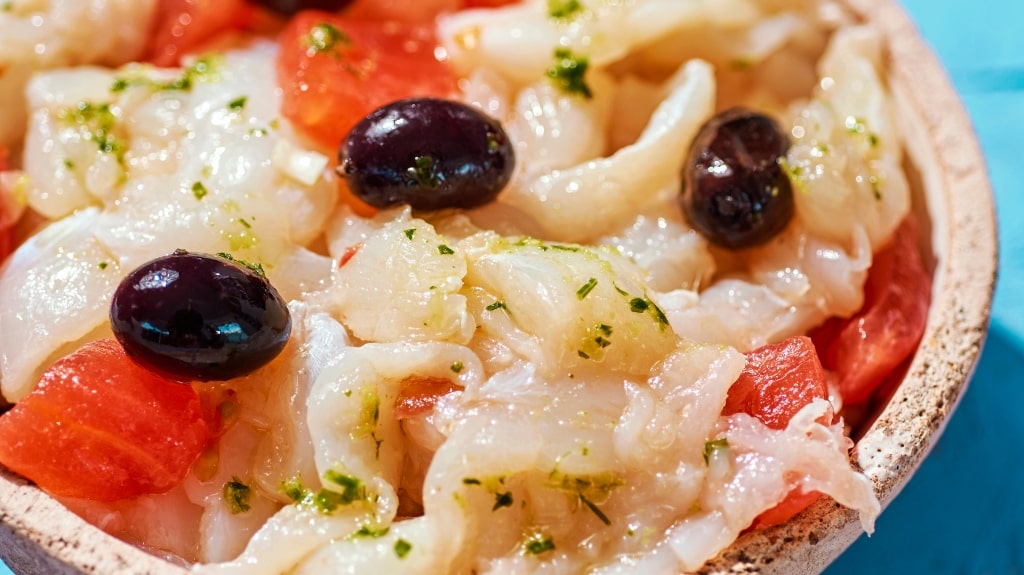
Barcelona is a foodies’ mecca. From simple Catalan dishes to extravagant multi-course dinners at the 66 Michelin-starred restaurants, culinary delights are guaranteed in the Catalan capital. If that’s not enough to make you visit Barcelona, how about the cocktail venues, which top the best bars in the world chart each year? Here’s just a short list of the foodgasms that await you in Barcelona:
- Pa amb tomàquet. The simple yet finger-licking tomato bread is a staple appetizer of Catalonian cuisine. Each restaurant and tapas bar has its own version of pan con tomate (in Spanish). The bread might be toasted, grilled, or simply warmed. It can come with garlic on top and chunks of tomato. Either way, the result will pleasure your taste buds.
- Esqueixada de bacallà. This traditional Catalan dish features salted codfish. The cold salad also includes tomatoes, onion, olive oil, and vinegar. Order the simple but flavorful result as an appetizer or a side dish. Some variations may also incorporate peppers, olives, or capers. Esqueixada de bacallà pairs well with cava, dry white wine, and vermouth.
- Fideuà. If you want to immerse yourself in the Catalonian culinary scene, a better option than paella is fideuà. The dish epitomizes short noodles, vegetables, and seafood such as squid, shrimp, and mussels. Chicken and rabbit meat might also join in the pan. The best place to try it is at one of the cozy seaside restaurants. Wash it down with copious amounts of local beer or wine.
- Bombas. The name “bomba” refers to the shape of this tasty treat. Similar to croquetas, bombas combine meat and mashed potatoes, which are shaped into a ball, covered in breadcrumbs, and deep-fried. The size of the bombas can vary from a small bite to a tennis ball. Share them with your companions and enjoy them with aioli.
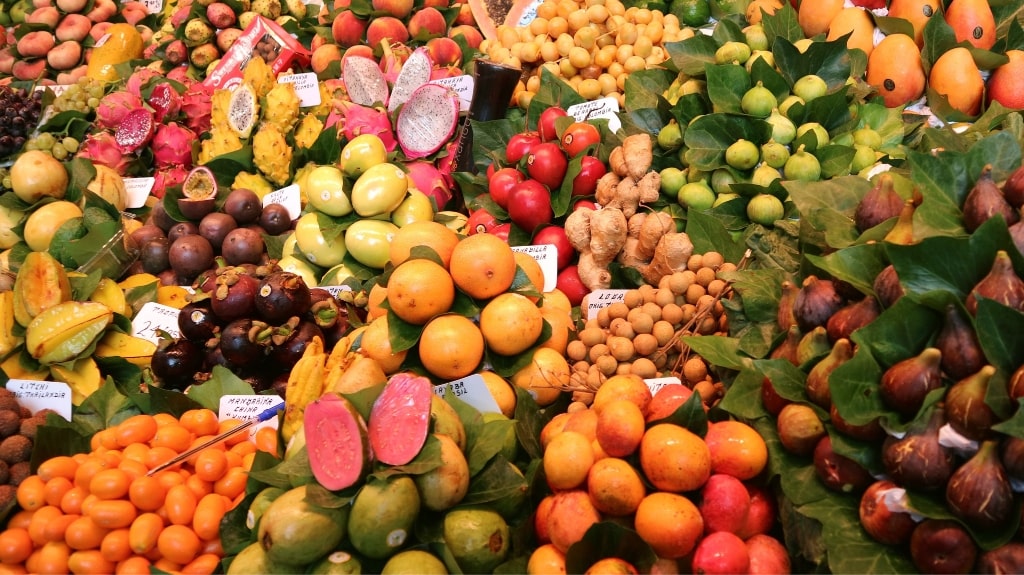
- Mató. The ultimate cheese seduction epitomizes soft and sweet goat cheese, similar to the Italian ricotta. It comes with fresh or dried fruit, honey, sugar, lemon zest, chocolate, or walnuts. The Catalonian dessert is similar to cheesecake, but it’s less sweet and has a stronger cheese flavor. It pairs perfectly with dry white wine, coffee, or tea.
- Crema Catalana. Sometimes called the Spanish crème brûlée, crema catalana is another dessert you should try in Barcelona. It consists of a custard base, infused with lemon zest, cinnamon, and vanilla, and covered with hardened caramelized sugar. Once you crack open that caramel, you’re in for a tempting treat. If you prefer a more adventurous take on crema catalana, order the coffee-infused version.
- Chocolate. Barcelona prides itself on its long tradition in chocolate making. The gourmet chocolatier Amatller was established in 1797 and still serves the oldest hot chocolate recipe. You can order the artisan hot drink and enjoy it in the surrounding of a Modernist palace inside the historic Casa Amatller. Alternatively, visit the Chocolate Museum to learn about the history of chocolate in Europe. Museu de la Xocolata displays chocolate statues of famous structures, such as the Sagrada Familia and Park Güell. Workshops for adults and kids, as well as a chocolate bar, will make you salivate. You can even eat your entry ticket as it’s made out of chocolate!
- Catalonian Sour. This staple cocktail incorporates typical Catalonian flavors. It joins locally produced cava, lemon juice, sugar, and egg whites. The egg whites give the cocktail a creamy and frothy texture. The Spanish sparkling wine – cava – provides a refreshing base. The lemon juice and sugar balance out the sweetness of the cava, and add a tangy, acidic flavor.
- Mercado de La Boqueria. You can enter the famous covered market in Ciutat Vella from the busy La Rambla. Inside the 13th-century marketplace, you’ll find diverse local and exotic fruits, vegetables, seafood, meats, cheeses, and baked goods. If La Boqueria is too busy for your taste, explore Mercat de Santa Caterina, Mercat de la Barceloneta, or Mercat de Sant Antoni. All of these historic marketplaces are great not only for finding fresh quality products but also for experiencing the city’s lively atmosphere.
Now You Know Why You Should Visit Barcelona, Spain

There you have it – the best 33 reasons to visit Barcelona.
The Catalan capital will steal your heart with its extravagant architecture, fabulous gastronomy, gorgeous beaches, and top-notch museums.
To best plan for your trip, don’t skip our Barcelona travel tips.
Now, tell us:
Do you think Barcelona is worth visiting?
Share your thoughts in the comment section.


